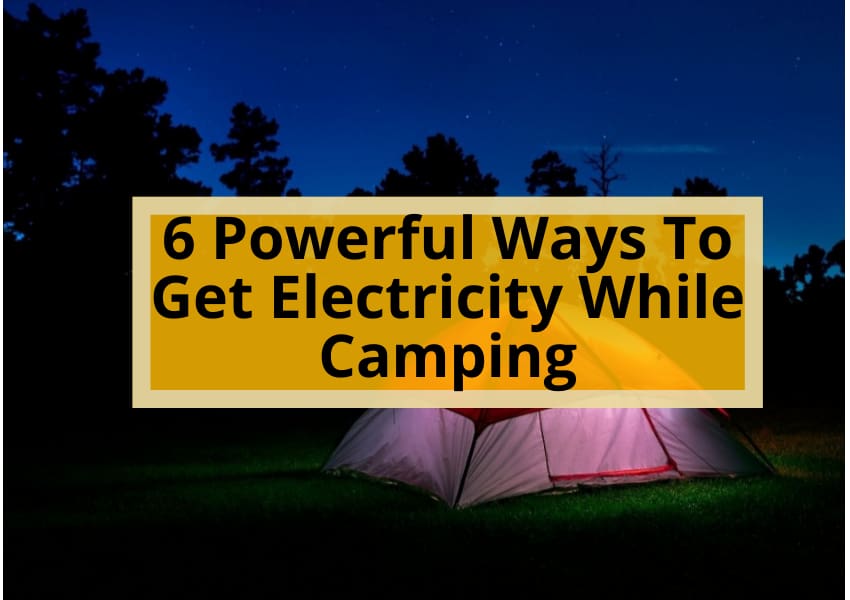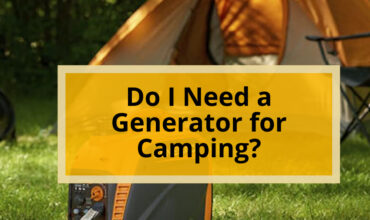Camping has always been a popular way for people to escape the hustle and bustle of city life and reconnect with nature. However, the reliance on electronic devices has made it difficult for many to completely disconnect from the world.
In fact, a recent survey found that 87% of people bring electronic devices with them on camping trips. This is where power solutions come in – they allow campers to stay connected while enjoying the great outdoors.
In this article, we will explore six powerful ways to get electricity while camping. We will discuss the pros and cons of different power sources, and provide recommendations for the best portable power station and power bank for camping.
We will also highlight the importance of charging devices safely and consider factors to keep in mind when choosing a power source. Additionally, we will delve into environmentally friendly power alternatives such as solar and water or wind turbines, which not only provide electricity but also have minimal impact on the environment.
By the end of this article, readers will have a comprehensive understanding of the different power solutions available for camping and be able to choose the best option for their needs.

Importance of Power Solutions
The availability of reliable power solutions is crucial for a successful camping trip, symbolizing the difference between a comfortable and enjoyable experience versus a challenging and inconvenient one. It is important to ensure that all devices are charged safely before heading out on a camping trip, as well as to consider the weight of the power solutions.
Portable power stations and power banks are popular options for camping, as they are lightweight, easy to use, and can provide power for a variety of devices. When choosing a power source for camping, it is important to consider the capacity, size and weight, budget, durability, and type of camping.
Additionally, it is recommended to invest in rugged power packs that are designed for outdoor use, as they are often more durable and resistant to damage. Weight is also an important consideration, as carrying heavy power solutions can be cumbersome and impact the overall experience.
By carefully selecting the right power solution, campers can ensure that they have access to reliable power and can enjoy their camping trips without worrying about running out of power.
Pros and Cons of Different Options
One consideration when choosing a power source for outdoor excursions is to weigh the advantages and disadvantages of various options. Two popular options are solar power and water/wind turbines. Solar power is a widely used option due to its ease of use and portability. However, the effectiveness of solar-powered chargers depends on the weather, and more expensive solar chargers are generally more reliable. On the other hand, water or wind turbines are environmentally friendly alternatives that are not affected by weather conditions. They can be expensive to purchase and install, but once set up, they can provide a reliable source of power for extended periods of time.
To further compare the pros and cons of different options, below is a table outlining the features of solar power and water/wind turbines:
| Feature | Solar Power | Water/Wind Turbines |
|---|---|---|
| Efficiency | Dependent on weather conditions | Not affected by weather conditions |
| Cost | Affordable to expensive | Expensive to purchase and install |
| Portability | Lightweight and portable | Can be bulky and less portable |
| Maintenance | Low maintenance | Requires regular maintenance |
| Environmental impact | Clean energy source | Clean energy source |
When choosing a power source, it is important to consider the factors that are most important to you, such as efficiency, cost, portability, maintenance, and environmental impact. Depending on your needs and budget, solar power or water/wind turbines may be the better choice for your camping trip.
also read : Apus & Bunk Heaters: Fuel Savings & Comfort
Factors to Consider in Choosing
Surprisingly, there are several factors that need to be considered when selecting a power source for outdoor excursions.
The first factor to consider is the capacity vs. weight. It is essential to choose a power source that can provide sufficient power to charge all necessary devices without adding too much weight to the camping gear. For example, if you only need to charge a few small devices, a power bank may be the perfect solution. Alternatively, if you require more power, a portable power station may be a better choice, but it will be heavier and bulkier.
The second factor is the budget vs. durability. While there are power solutions available at different price points, it is vital to choose one that is durable and can withstand the rigors of outdoor activities. Investing in a rugged power pack designed for the outdoors is a wise choice, as it will likely last longer and provide a more reliable power source.
Additionally, it is essential to consider the type of camping and must-have items when selecting a power source. For instance, if you plan to camp in a remote location without access to a power source, a solar-powered charger may be the best option. On the other hand, if you need to charge larger devices like a laptop or camera, a portable power station may be necessary.
Frequently Asked Questions
How long do portable power stations typically last before needing to be recharged?
Portable power stations typically last between 4-12 hours before needing to be recharged, depending on their capacity and charging options. Managing power usage by prioritizing essential devices can extend battery life while camping.
Can solar-powered chargers be used in any type of weather?
While solar-powered chargers are a popular option for camping, their effectiveness depends on the weather. Durability of solar panels is important for reliability. It may be worth considering alternative power sources such as water or wind turbines for more consistent power.
Are water or wind turbines a practical option for camping trips?
Pros and cons exist for using water or wind turbines as a power source while camping. The sustainability of turbines varies based on location and weather. Additional factors, such as cost and weight, should also be considered before deciding on a power source for camping.
How much do rugged power packs designed for the outdoors typically cost?
When comparing the cost of rugged power packs designed for outdoor use, prices can range from around $100 to over $1000 depending on the brand and features offered. Brands available include Goal Zero, Jackery, and Anker.
What safety precautions should be taken when charging power solutions before heading out on a camping trip?
Precautionary measures must be taken when charging power solutions before heading out on a camping trip. Safety tips include using a surge protector, charging in a well-ventilated area, and avoiding overcharging. It is also important to follow manufacturer instructions and use compatible cables.






